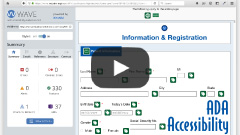 The official rulebook on Website Accessibility is still fairly vague, and like most regulations, is constantly being revised.
The official rulebook on Website Accessibility is still fairly vague, and like most regulations, is constantly being revised.
Five years ago, the U.S. Department of Justice wrote “Consequently, the Department is planning to amend its regulation implementing title II of the ADA to require public entities that provide services, programs or activities to the public through Internet web sites to make their sites accessible to and usable by individuals with disabilities.” Like many regulations, it's still not been made into law…
Enforcement is Really Happening
So while there is still not a specific Federal regulation on website accessibility, there are many new State regulations on the books doing exactly that, with more on the way. In 2017 the first case to go to trial occurred in Florida. It resulted in Winn-Dixie (Gil v. Winn-Dixie) being required to pay $250,000 to bring its website up to WCAG standards.
And the trend is growing quickly. In 2021 (the latest year figures are available) there were 11,400 website accessibility lawsuits — up 320 percent over 2013. The types of businesses seeing legal challenges besides retailers are hotels, travel, healthcare, financial institutions, and educational facilities.
Are Your Forms Accessible?
So with all that in mind, are your patient forms accessible? Unless they’ve been specifically designed that way, probably not. Basic PDF forms are not, and many webforms (especially older ones) are not either. There is a specific set of rules that a form designer must follow to make any form accessible, and the rules aren’t exactly simple or easy to follow. And if you’re thinking that using one of those “Build Your Own Forms” websites will take care of the problem, hardly any of the top ones claim to be able to create accessible forms.
So like most anything else in business, if you want to be safe you really ought to do things the right way…


